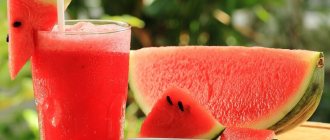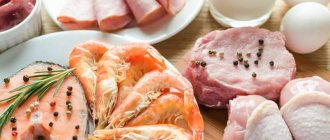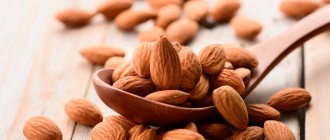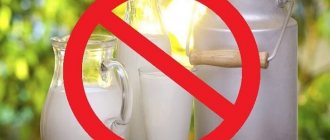Watermelon is the name given to the fruit of a herbaceous annual plant of the Cucurbitaceae family, called pumpkin. Pumpkin is a berry, the largest known, and can have different shapes - a regular ball, an oval, a cylinder and even a cube. According to the culinary classification, watermelon is a fruit. The color of the hard peel is found in various variations, from light to dark green with almost black stripes, spots or mesh. Between the crust and the bright red juicy pulp there is a white layer of varying thickness, from a few millimeters to 4-5 cm (jam is made from such crusts and candied fruits are prepared). The flesh is traditionally red, but breeders boast yellow or orange watermelons inside. Watermelon seeds vary from small (0.5 cm) to medium (1-1.5 cm), and they also vary in color - white, dark brown or combined.
Chemical composition of watermelon
The composition of watermelon is 91% water, and the remaining percentages are amino acids, carbohydrates, pectin, ash, and alkaline substances.
Minerals included: calcium; potassium; magnesium; sodium; phosphorus; selenium; copper; manganese; iron; fluorine; zinc. Watermelons contain lycopene, beta-carotene, B vitamins (thiamine, riboflavin, folate, pyridoxine, choline), ascorbic and nicotinic acids, alpha-tocopherol acetate (vitamin E), phylloquinone (vitamin K), betaine.
Popular articles for weight loss and health
Chia pudding: recipe with coconut milk
Diet 5 spoons: menu for the week real reviews
Homemade granola diet recipe
One Glass Diet
How to choose a good product?
You can buy a ripe and sweet specimen no earlier than August.
Supermarkets often sell unripe products, so it is better to purchase watermelons at the market. You should not choose a fruit that is too small - it is a big risk to buy green fruit; it is also better to ignore overgrown ones. The optimal weight of a watermelon is 5-7 kg.
A ripe watermelon has a hard and tough rind with contrasting stripes. Only an unripe fetus can have a soft crust. On one side you can see a light yellow spot - which means that it was on this side that the watermelon came into contact with the ground. Normally, the diameter of this spot is from 5 to 10 cm. If it is much larger, most likely it did not receive enough sunlight and the flesh will be unsweetened.
You need to pay attention to the tail. If the stalk is torn off, this is a bad sign; perhaps the seller did this to hide the low-quality fruit. A ripe fruit has a tail that is yellow and dry, but not overdried.
What can you tell by the color of the flesh if the watermelon has already been cut? If it is purple, it means that artificial fertilizers and nitrates were used during cultivation. A “correct” berry will have bright red flesh, while an unripe one will have pale flesh. Seeds should normally be dark brown in color.
Delicious and healthy recipes
Watermelon is a seasonal delicacy that is sure to bring benefits if consumed wisely. Those who want to lose weight will find many delicious and healthy recipes for themselves.
Since its pulp contains many macroelements, all these recipes will allow you not only to enjoy the sweet taste, but also to improve your health.
- Recipe 1. Mint ice cream. For this, you need to choose a watermelon that is as sweet as possible. Cut the pulp into pieces, mix with 1 tbsp. l. Sahara. Add chopped mint or lemon balm leaves and squeeze the juice of three limes. Place the entire mixture in a blender and grind thoroughly. Place into portioned containers and freeze.
- Recipe 2. Salad with watermelon. Surprisingly, the sweet berry goes well with cheese. Thanks to the onions, the taste of the salad is especially unusual. You need to cut the pulp into small pieces, mix with chopped bell pepper and dessert onions. You will also need 200g. Feta cheese. The dish is seasoned with olive oil.
- Recipe 3. Watermelon milkshake. Why not try making drinks? To prepare two servings of cocktail, you need to mix 500g in a blender. watermelon pulp, 200g. milk and a small amount of sugar, 2-3 tbsp. spoons.
- Recipe 4. Watermelon drink. 2 kg. Turn the watermelon pulp into a homogeneous mass. Combine with 1 l. water. Add sugar or honey to taste. Strain the drink through a fine sieve. Before serving, add ice cubes and mint sprigs to glasses.
- Recipe 5. Watermelon jam. To prepare it you will need watermelon rinds. 1 kg. Cut the crust into small squares 1 cm thick, squeeze the juice of 3 lemons or limes, add 1 kg. sugar, mix everything. Leave for 8 hours. Place on low heat and cook for 30 minutes. Turn off the heat for 2 hours, cook for another 10 minutes. Place the jam into sterile jars.
All these recipes are quite simple to make and will appeal to both children and adults. Dishes can be prepared for a party, or you can diversify your daily diet with them.
Useful properties of watermelon
A large amount of magnesium helps remove toxins and excess cholesterol from the body. With its help, the skin becomes more elastic, and the muscles become strong and toned. The fruits have a lot of potassium. This microelement improves the functioning of the cardiovascular system. The seeds contain organic acids: linolenic, palmitic and linoleic.
Due to the ability of watermelon to remove toxins and waste from the body, it is recommended for people working in hazardous industries and after alcohol abuse. The pulp is able to gently remove excess liquid, while simultaneously removing excess salt deposits. Therefore, consumption of the berry is indicated for a number of diseases: rheumatism, arthritis, gout. Fresh juice helps with cystitis and children's bedwetting. Serves as an effective preventive drink against cold viruses and in case of vitamin deficiency, which is especially important in the summer and autumn periods.
Antioxidants in watermelon prevent the appearance of signs of skin aging and resist the development of cancerous tumors. The product is indicated for fresh consumption by people suffering from kidney diseases: cystitis, nephritis, pyelonephritis. The sugars in the berry are well tolerated by diabetics. Therefore, there are no contraindications for health, except for following the norm: in the first stage of the disease you can eat no more than 300 grams per day, in the second - 600 grams, divided by 4 times. The juicy pulp has a tonic effect.
The nutritional value
To find out how high the calorie content of watermelon is, let's analyze its composition. He will tell us about the benefits of the product and its safety for those losing weight. Such close attention to watermelon nutrients reveals the following facts:
- Water makes up one-ninth of the fruit.
- It contains absolutely no fat or cholesterol.
- 100 grams of fruit pulp contains 0.6 g of protein and 7.5 carbohydrates, most of which are simple carbohydrates (6.2 g) and fiber (0.4 g).
- The sweet taste is due to the presence of sucrose (1.21 g), glucose (1.58 g) and fructose (3.36 g).
- The berry contains minerals:
- Watermelon is a source of vitamins:
- iron - 1.3% of human needs per day;
- magnesium - 2.5%;
- phosphorus - 1.1%;
- potassium - 2.4%;
- calcium - 0.7%.
- C - 13.5% of a person’s daily needs;
- A - 11.4%;
- group B (thiamine, riboflavin, nicotinic and pantothenic acid).
Benefit
Thus, watermelon pulp contains a lot of potassium, vitamins A and C. Therefore, the fruit is recommended for diseases of the kidneys, liver, stomach, heart and blood vessels. It stimulates digestion and prevents cancer. It is known to effectively remove toxins and cholesterol plaques, and has a beneficial effect on the skin and hair. It is a strong antioxidant and strengthens the immune system. But this unconditional usefulness is violated by the abundance of sugar. How will it affect the calorie content of watermelon?
Did you know that eating watermelon can make you gain weight?
“It has been confirmed that the calorie content of watermelon per 100 grams is only 25-38 kcal. This is a one-of-a-kind sweetness that will never lead to completeness...”
Do you believe this? Then, when you see increased numbers on the scales, look for other options that provoked the sad fact.
For now, we’ll tell you how a low-calorie watermelon “dessert” gives an unexpected increase in kilogram equivalent:
Together with a loaf of white bread, rapid weight gain is guaranteed. A cool option for bodybuilders (they use it often). For those who want to have a slender silhouette, scarlet pulp in combination with flour products is “killer”!
Watermelon does not satisfy hunger; its glycemic index is very high - your appetite will definitely increase within an hour after eating the berry. It is important to refrain from indiscriminate consumption of fatty and protein foods.
It’s easy to finish a whole green striped “ball” in one sitting. But the arithmetic of “sugar pleasure” will give a disappointing result. 38 kcal is a small piece; a ripe watermelon itself weighs on average 6 kg. Multiply and calculate the total calorie content of the berry - 2280 kcal (this is the optimal amount of all calories consumed per day). You're not limited to just watermelon, are you? The counter is creeping up along with the kilograms!

Benefits of seeds
The seeds have high nutritional value due to their high protein content. Amino acids (lysine, arginine, tryptophan) promote muscle growth and increase stress resistance. Niacin makes your skin healthier. Watermelon seeds reduce the risk of developing urolithiasis and improve vision.
The seeds can be dried or fried, this will not reduce their beneficial properties.
Watermelon seeds should not be consumed if you have citrullinemia (a condition in which the substance that releases ammonia into the urine is not produced). When consuming seeds in this case, ammonia will be retained in the body, which can lead to poisoning.
Watermelon seeds are considered very beneficial for men's health. They serve to prevent the formation of prostate adenoma, increase testosterone synthesis, which has a positive effect on the entire body.
How to avoid getting caught up in this weight gain trend?
Practice watermelon fasting days without mixing the juicy pulp with other food. There will be a cleansing of toxins with excellent absorption of useful elements, of which watermelon is rich. Limit salt in your diet, then avoid swelling in the morning.
This berry should act as a snack, and not as an addition to the main table menu. Keep an interval of 1.5-2 hours before and after main meals - this is the best time for a treat.
Add variety to any boring diet when hunger overcomes and eating something substantial is prohibited. The life-giving moisture of watermelon depths will give you a feeling of satiety and sweetness. Maybe not for long, but still. You will become more positive, the motivation to lose weight will not disappear!
Nutritionist's recommendations
Nutritionists recommend eating watermelon, whose calorie content for weight loss is quite high, under strict control. If you really want to taste the aromatic pulp, follow these tips:
Eat it on its own without adding extra calories with additional food.
Use for fasting days. But it should only be one day. To dull the feeling of hunger during the day, divide the whole fruit into 5-6 doses.
A one-week watermelon diet sounds scary. Such strict diets are strictly prohibited by nutritionists, because they are a lot of stress for the body.
If you choose watermelon for a snack, then choose the middle between two main meals.
The daily dose of fruit should not exceed 2-2.5 kg.
When losing weight in the evening, you can eat only a small piece.
Healthy watermelon with low calorie content is not a myth. Its benefits have been proven. Only for those on a diet there are small restrictions, subject to which the fruit will become your assistant on the thorny path to your dream figure.
Application for weight loss
Due to its taste and availability, watermelon has gained a large number of fans around the world as a means of losing weight. Rave reviews from girls and women who have painlessly lost several extra pounds confirm the effectiveness of the watermelon diet. If you get out of it correctly and then follow the principles of a healthy diet, you can consolidate the results for a long time.
In order to cleanse the body and correct body weight, fasting days are spent on fruit pulp, which involves drinking watermelons and water in an amount of 2-3 liters. Despite the fact that the berry itself is juicy, free liquid is necessary to normalize the water-salt balance and to activate the process of removing waste and toxins from the body resulting from the decomposition of fatty deposits.
One- and two-day fasting diets are usually . Their frequency varies widely, but the most optimal frequency of fasting days is once every 7-10 days.
A more strict version of the diet is designed for five days and includes only permitted watermelon pulp in the amount of 1 kg per 10 kg of body weight + 2 liters of still purified water. This option for losing weight is unbalanced; the body experiences a deficiency of calories and other essential micro- and macroelements, vitamins, and is difficult to tolerate.

Negative consequences are possible in the form of rapid weight restoration and slower metabolism. Only people who do not have gastrointestinal diseases can practice this method of weight loss.
It is more rational to carry out a ten-day gentle watermelon diet , in the menu of which the pulp of fresh ripe watermelons is supplemented with water and unsweetened green tea, whole grain, rye or bran bread. The maximum result that can be achieved is minus 10 kg. The average figures vary between 5-7 kg.
During the diet, pasta, alcohol, energy drinks, bread, sugar-containing foods, snacks, and snacks are completely excluded . To consolidate the results, it is important to consume low-calorie dairy products, cheese, lean salads and vegetable soups, lean meats and fish for a few more weeks after completing the diet.
Afterwards, watermelon pulp is included in the diet at the rate of 1 kg per 30 kg of human body weight.
Is it possible to eat watermelon while on a diet?
Delicate watermelon fiber has a delicate laxative property and helps to improve intestinal motor function, which means to cope with constipation and helps eliminate cholesterol.
Important:
- Patients with diabetes mellitus, kidney stones, severe diseases of the pancreas, prostate gland, and pyelonephritis should not consume watermelon in large quantities.
- You should not eat watermelon at the same time with pickles: salt retains fluid in the body, so in this case swelling is possible.
- You need to make sure that the watermelon you buy does not contain nitrates. Eating watermelon with a high content of nitrates can cause nausea, vomiting, and diarrhea. Nitrates are especially dangerous for children and kidney patients.
If you are unsure about the purity of the watermelon, eat only the middle of the fruit, since nitrates in watermelon accumulate mainly in and around the rind.
Super selection of diets
Salad Brush for weight loss recipe reviews and how much they discount
90 day separate food diet: menu for every day
Egg Diet for 4 weeks: detailed menu in the table
Ginger for weight loss: a recipe for the most effective method
Popular varieties
There are many different varieties of this melon crop, which differ both in appearance and in taste. The most popular and valuable are:
- Astrakhan. The most common variety. Watermelon is round or oblong, the flesh is sugary. Contains the largest amount of magnesium and potassium.
- Crimson Sweet. Round, like a ball, with sweet and fluffy flesh. It contains vitamins and minerals, but also contains more sugar than other varieties.
- Ogonyok. It is shaped like a regular ball. The skin is thin, without stripes. The flesh is tender.
- A gift from the sun. Yellow, similar in appearance to melon, but with red flesh inside. More fragrant than other varieties.
- Skorik. Early ripening variety. It has thick skin and a pattern of curved lines. According to gourmets, its pulp is the most tender and aromatic.
Contraindications and possible harm of watermelon
Watermelon should be consumed with caution for the following diseases:
- Urolithiasis (the berry provokes the movement of stones).
- Diabetes mellitus type 2. This pathology is not an absolute contraindication. Before use, it is recommended to consult a doctor who will calculate the permitted portion.
- Allergic reaction.
- Colitis.
- Diarrhea.
Watermelon can cause harm to the body if it contains large amounts of nitrates. They are used to quickly ripen and increase fruit weight. Consumption of nitrate fruits leads to serious poisoning. Symptoms of this condition are weakness, dizziness, nausea, fever, vomiting, and diarrhea. It is especially dangerous in childhood.
The glossy surface of the watermelon, the bright red color of the pulp, and the yellow fibers inside indicate the presence of a large amount of chemical nitrates.
It is not recommended to purchase cracked or cut watermelons, since in this case there is a high risk of dangerous bacteria getting inside.
Selection rules
Buying a watermelon is a very important aspect, since it determines whether it will be harmful or whether the product will be beneficial. Rules for choosing a good watermelon:
- A slice of watermelon is immersed in water. If nitrates are present, the liquid will turn pink or red. If absent, it will only muddy it;
- The fruit needs to be squeezed. There is no crackling, but it looks mature? Indicates chemical additives;
- When cut, a watermelon does not have a perfectly smooth surface; the pulp contains sugar grains and whitish-pinkish thin veins.
Permissible rate of nitrates: 60 mg per 1 kg of fruit. The accumulation occurs unevenly, and to avoid possible ingestion of toxins into the body, it is not recommended to take very large fruits. The average fruit weight does not exceed 8 kg, although it depends on the variety.
It is advisable to give children only the core, it is healthier and tastier.











